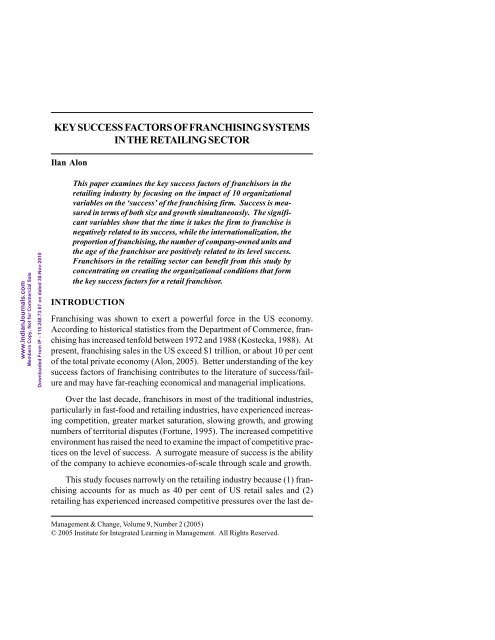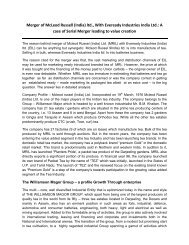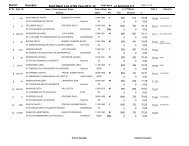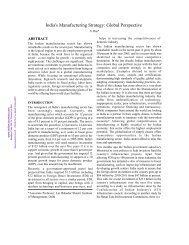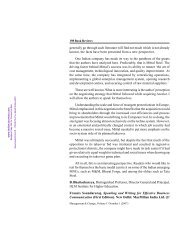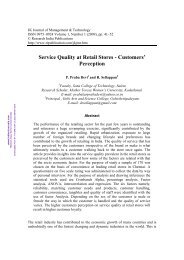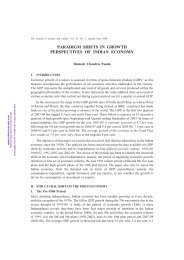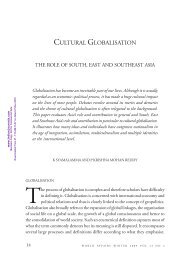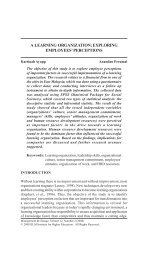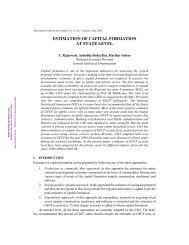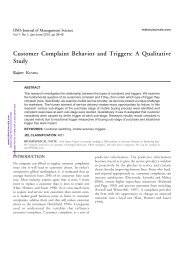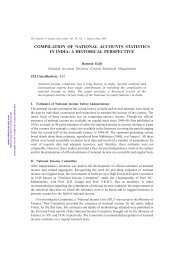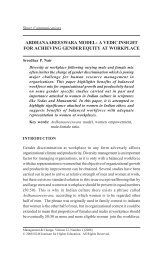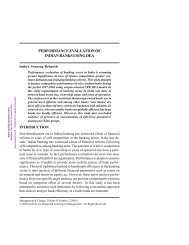Key Success Factors of Franchising Systems In the ... - Mimts.org
Key Success Factors of Franchising Systems In the ... - Mimts.org
Key Success Factors of Franchising Systems In the ... - Mimts.org
You also want an ePaper? Increase the reach of your titles
YUMPU automatically turns print PDFs into web optimized ePapers that Google loves.
KEY SUCCESS FACTORS OF FRANCHISING SYSTEMS<br />
IN THE RETAILING SECTOR<br />
Ilan Alon<br />
www.<strong>In</strong>dianJournals.com<br />
Members Copy, Not for Commercial Sale<br />
Downloaded From IP - 115.248.73.67 on dated 30-Nov-2010<br />
This paper examines <strong>the</strong> key success factors <strong>of</strong> franchisors in <strong>the</strong><br />
retailing industry by focusing on <strong>the</strong> impact <strong>of</strong> 10 <strong>org</strong>anizational<br />
variables on <strong>the</strong> ‘success’ <strong>of</strong> <strong>the</strong> franchising firm. <strong>Success</strong> is measured<br />
in terms <strong>of</strong> both size and growth simultaneously. The significant<br />
variables show that <strong>the</strong> time it takes <strong>the</strong> firm to franchise is<br />
negatively related to its success, while <strong>the</strong> internationalization, <strong>the</strong><br />
proportion <strong>of</strong> franchising, <strong>the</strong> number <strong>of</strong> company-owned units and<br />
<strong>the</strong> age <strong>of</strong> <strong>the</strong> franchisor are positively related to its level success.<br />
Franchisors in <strong>the</strong> retailing sector can benefit from this study by<br />
concentrating on creating <strong>the</strong> <strong>org</strong>anizational conditions that form<br />
<strong>the</strong> key success factors for a retail franchisor.<br />
INTRODUCTION<br />
<strong>Franchising</strong> was shown to exert a powerful force in <strong>the</strong> US economy.<br />
According to historical statistics from <strong>the</strong> Department <strong>of</strong> Commerce, franchising<br />
has increased tenfold between 1972 and 1988 (Kostecka, 1988). At<br />
present, franchising sales in <strong>the</strong> US exceed $1 trillion, or about 10 per cent<br />
<strong>of</strong> <strong>the</strong> total private economy (Alon, 2005). Better understanding <strong>of</strong> <strong>the</strong> key<br />
success factors <strong>of</strong> franchising contributes to <strong>the</strong> literature <strong>of</strong> success/failure<br />
and may have far-reaching economical and managerial implications.<br />
Over <strong>the</strong> last decade, franchisors in most <strong>of</strong> <strong>the</strong> traditional industries,<br />
particularly in fast-food and retailing industries, have experienced increasing<br />
competition, greater market saturation, slowing growth, and growing<br />
numbers <strong>of</strong> territorial disputes (Fortune, 1995). The increased competitive<br />
environment has raised <strong>the</strong> need to examine <strong>the</strong> impact <strong>of</strong> competitive practices<br />
on <strong>the</strong> level <strong>of</strong> success. A surrogate measure <strong>of</strong> success is <strong>the</strong> ability<br />
<strong>of</strong> <strong>the</strong> company to achieve economies-<strong>of</strong>-scale through scale and growth.<br />
This study focuses narrowly on <strong>the</strong> retailing industry because (1) franchising<br />
accounts for as much as 40 per cent <strong>of</strong> US retail sales and (2)<br />
retailing has experienced increased competitive pressures over <strong>the</strong> last de-<br />
Management & Change, Volume 9, Number 2 (2005)<br />
© 2005 <strong>In</strong>stitute for <strong>In</strong>tegrated Learning in Management. All Rights Reserved.
36 <strong>Key</strong> <strong>Success</strong> <strong>Factors</strong> <strong>of</strong> <strong>Franchising</strong> <strong>Systems</strong> <strong>In</strong> <strong>the</strong> Retailing Sector<br />
cade. The concentration on a single industry is also experimentally preferred<br />
(Dant, et al,. 1996; Sen, 1998; and Alon, 1999).<br />
A growing, but contrasting, evidence on <strong>the</strong> success and failure <strong>of</strong><br />
franchisors needs to be examined. While some studies point to <strong>the</strong> success<br />
<strong>of</strong> franchising over independent businesses (e.g., Justis, et al., 1992;<br />
Castrogiovanni, et al. 1993; and IFA, 1998), a growing literature that is<br />
critical <strong>of</strong> this view is emerging (e.g., Bates, 1995; and Stanworth, et al.<br />
1997). An examination into <strong>the</strong> causal factors <strong>of</strong> success among franchisors<br />
should, <strong>the</strong>refore, broaden <strong>the</strong> body <strong>of</strong> knowledge on this critical issue.<br />
www.<strong>In</strong>dianJournals.com<br />
Members Copy, Not for Commercial Sale<br />
Downloaded From IP - 115.248.73.67 on dated 30-Nov-2010<br />
This study attempts to develop a managerially useful framework, which<br />
has <strong>the</strong> potential to help franchisors develop better strategies to achieve<br />
competitive advantage. The focus is, <strong>the</strong>refore, on <strong>the</strong> controllable elements<br />
<strong>of</strong> <strong>the</strong> franchising <strong>org</strong>anization (<strong>org</strong>anizational factors). <strong>Factors</strong> that are<br />
selected are also readily available to prospective franchisees and investors<br />
prior to <strong>the</strong> purchase, thus potentially increasing <strong>the</strong> rationality <strong>of</strong> <strong>the</strong> decision.<br />
MODEL DEVELOPMENT<br />
The literature <strong>of</strong> success/failure <strong>of</strong> franchisors has shown inconclusive findings.<br />
While studies sponsored by franchising associations, most notably <strong>the</strong><br />
<strong>In</strong>ternational Franchise Association and <strong>the</strong> British Franchise Association,<br />
have found that franchising is a highly successful method <strong>of</strong> doing business,<br />
a few o<strong>the</strong>r reports argued to <strong>the</strong> contrary.<br />
An IFA survey <strong>of</strong> 1,001 franchisees selected randomly from 4,000 registered<br />
franchisors conducted by <strong>the</strong> Gallup Organization between September<br />
and October 1997 and released in March 1998 found that 8 out <strong>of</strong> 10<br />
were small businesses with only one franchise; 92 per cent <strong>of</strong> franchisees<br />
considered <strong>the</strong>mselves very or somewhat successful; <strong>the</strong> majority <strong>of</strong> franchise<br />
owners were satisfied with <strong>the</strong>ir business; 65 per cent say <strong>the</strong>y would<br />
purchase <strong>the</strong> franchise again if given <strong>the</strong> opportunity; 93 per cent believe<br />
that being associated with <strong>the</strong> franchise gives <strong>the</strong>m a competitive advantage;<br />
72 per cent said <strong>the</strong>ir expectations were met; and on average, gross<br />
earnings ranged from $76,000 for a single unit franchisee to $142,000 for a<br />
multiple-unit franchisee. The picture that emerges is that franchising is a<br />
highly successful method <strong>of</strong> doing business which provides sustainable com-<br />
Management & Change, Volume 9 Number 2 (2005)
Ilan Alon 37<br />
petitive advantage and a reasonable standards <strong>of</strong> living for its owners.<br />
<strong>In</strong> contrast to <strong>the</strong> IFA findings, ano<strong>the</strong>r group <strong>of</strong> research suggested<br />
that franchise associations have an interest in promoting <strong>the</strong> franchise concept,<br />
particularly to politicians and investors. Thus, <strong>the</strong>y are more likely to<br />
be biased (Stanworth, et al. 1997). Fortune magazine (1995), for example,<br />
reported that since <strong>the</strong> mid-1980s, franchising growth ei<strong>the</strong>r matched or<br />
lagged behind GDP growth. Stanworth, et al. (1997) found that US franchising<br />
growth has kept pace with whole US economy, while in <strong>the</strong> UK, <strong>the</strong><br />
franchise industry experienced negative real growth. The authors noted<br />
that in <strong>the</strong> UK franchisee survival rate is no different from o<strong>the</strong>r start-up<br />
firms over a five-year period.<br />
www.<strong>In</strong>dianJournals.com<br />
Members Copy, Not for Commercial Sale<br />
Downloaded From IP - 115.248.73.67 on dated 30-Nov-2010<br />
<strong>Franchising</strong> is viewed as a hybrid <strong>org</strong>anization form that has element <strong>of</strong><br />
markets and hierarchies because <strong>the</strong> franchisor retains some ownership<br />
and control, but gives up <strong>the</strong> operations <strong>of</strong> <strong>the</strong> units. Two popular approaches<br />
to explaining <strong>the</strong> use <strong>of</strong> franchising have been resource-scarcity and agency<br />
<strong>the</strong>ories. Most studies using <strong>the</strong>se <strong>the</strong>ories have tried to explain <strong>the</strong> factors<br />
associated with <strong>the</strong> proportion <strong>of</strong> franchising. The <strong>the</strong>ory <strong>of</strong> resource scarcity<br />
suggests that firms initially franchise because <strong>the</strong>y lack <strong>the</strong> resources<br />
for expansion. Such resources are not merely financial (capital scarcity),<br />
but also managerial, knowledge-based, <strong>org</strong>anizational, etc. The agency perspective,<br />
on <strong>the</strong> o<strong>the</strong>r hand, focuses on <strong>the</strong> monitoring skills <strong>of</strong> <strong>the</strong> franchisor.<br />
According to <strong>the</strong> agency perspective, firms franchise because <strong>the</strong>y are<br />
unable to monitor <strong>the</strong>ir managers efficiently. Because franchisees have a<br />
residual claim on sales, shirking is avoided and <strong>the</strong> need for monitoring is<br />
diminished (Shane, 1996a). A number <strong>of</strong> recent studies have shown that<br />
<strong>the</strong>se <strong>the</strong>ories are complementary (Combs and Castrogiovanni 1994; Combs<br />
and Ketchen 1999; and Alon, 2000).<br />
<strong>Franchising</strong> Speed: Years-To-<strong>Franchising</strong><br />
<strong>Franchising</strong> reduces <strong>the</strong> agency problems <strong>of</strong> firm growth because (1) it<br />
reduces <strong>the</strong> cost associated with selecting, assimilating and monitoring new<br />
employees, (2) limits <strong>the</strong> cost <strong>of</strong> determining <strong>the</strong> abilities <strong>of</strong> store managers,<br />
and (3) decreases shirking and moral hazard since <strong>the</strong> franchisee is a residual<br />
claimant. <strong>Franchising</strong> promotes rapid development <strong>of</strong> economies-<strong>of</strong>scale<br />
and economies-<strong>of</strong>-scope, lowering <strong>the</strong> cost per unit and increasing <strong>the</strong><br />
firm’s competitive stance (Shane, 1996a). <strong>Franchising</strong> also provides <strong>the</strong><br />
Management & Change, Volume 9 Number 2 (2005)
38 <strong>Key</strong> <strong>Success</strong> <strong>Factors</strong> <strong>of</strong> <strong>Franchising</strong> <strong>Systems</strong> <strong>In</strong> <strong>the</strong> Retailing Sector<br />
franchisor with <strong>the</strong> resources, such as managerial input, local market knowledge,<br />
labor and capital, for growth. Franchisors in <strong>the</strong> retailing sector, particularly<br />
emerging ones, are faced with high levels <strong>of</strong> competition and market<br />
saturation. This competitive framework necessitates franchisors to grow<br />
rapidly. “When new franchisors enter industries in which <strong>the</strong>y face established<br />
competitors, <strong>the</strong> speed with which <strong>the</strong>y grow to a size at which <strong>the</strong>y<br />
can operate at a competitive cost is important” (Shane, 1996a, p. 221).<br />
H1: The shorter <strong>the</strong> length <strong>of</strong> time it takes <strong>the</strong> retailer to franchise, <strong>the</strong><br />
higher its chances <strong>of</strong> success.<br />
<strong>Franchising</strong> <strong>In</strong>ternationalization<br />
www.<strong>In</strong>dianJournals.com<br />
Members Copy, Not for Commercial Sale<br />
Downloaded From IP - 115.248.73.67 on dated 30-Nov-2010<br />
The internationalization <strong>of</strong> franchising systems has received a lot <strong>of</strong> attention<br />
in recent years from researchers and practitioners alike. The general<br />
consensus is that franchisors that internationalize <strong>the</strong>ir systems can achieve<br />
critical scale and be more competitive in <strong>the</strong> long run (Welsh and Alon,<br />
2002; Alon and Welsh, 2003). Operating a franchise system across heterogeneous<br />
locations develops <strong>the</strong> franchisor’s monitoring capabilities and distance<br />
management skills (Alon, 1999). Franchisors that seek franchisees<br />
throughout <strong>the</strong> world expand <strong>the</strong>ir potential market <strong>of</strong> franchisees, appreciating<br />
<strong>the</strong>ir opportunities for success (Alon and Welsh, 2001).<br />
H2: Franchisors that seek internationalization are more likely to be<br />
successful.<br />
<strong>Franchising</strong> Strategy: Proportion <strong>Franchising</strong><br />
While <strong>the</strong> determinants <strong>of</strong> <strong>the</strong> proportion <strong>of</strong> franchising have been examined<br />
(e.g., Alon, 2001), few studies focused on <strong>the</strong> impact <strong>of</strong> <strong>the</strong> proportion<br />
<strong>of</strong> franchising on <strong>the</strong> firm’s success. Falbe and Welsh, (1998) found that <strong>the</strong><br />
proportion <strong>of</strong> franchising is positively related to system quality, brand name,<br />
and <strong>the</strong> level <strong>of</strong> communication, among o<strong>the</strong>r factors. Business belonging<br />
to franchisors and franchisees that have a higher proportion <strong>of</strong> franchising<br />
were less likely to fail. The franchisor failure variables included illegal/<br />
unethical conduct, misrepresentation/ dishonesty, market saturation, faddish<br />
product appeal, over expansion, and competition from company-owned units.<br />
The franchisee variables consisted <strong>of</strong> unwillingness to follow <strong>the</strong> system or<br />
get involved, misrepresentation/dishonesty, failure to pay vendors on time,<br />
inadequate facility maintenance, expanding too rapidly, poor local economic<br />
Management & Change, Volume 9 Number 2 (2005)
conditions, overstaffing <strong>of</strong> facility, inappropriate inventory levels, and overcapitalization.<br />
H3: Franchisors that have a higher proportion <strong>of</strong> franchising units<br />
are more likely to be successful.<br />
Company-Owned Outlets<br />
Ilan Alon 39<br />
www.<strong>In</strong>dianJournals.com<br />
Members Copy, Not for Commercial Sale<br />
Downloaded From IP - 115.248.73.67 on dated 30-Nov-2010<br />
The number <strong>of</strong> company owned units necessary by a franchisor may have<br />
an impact on <strong>the</strong> franchisor’s level <strong>of</strong> success. The “rule <strong>of</strong> thumb” <strong>of</strong>ten<br />
used by franchising practitioners is that a franchisor should at <strong>the</strong> very least<br />
operate two units over three years or three units over two years. Franchisor<br />
owned outlets serve many important functions in <strong>the</strong> franchising system. It<br />
allows <strong>the</strong> franchisor to test new concepts, innovate with its management<br />
systems, stay in touch with <strong>the</strong> customers, and learn from ongoing operations.<br />
<strong>In</strong> a study by Alon (2001), retailers with a larger scale also were able<br />
to achieve higher growth rate in <strong>the</strong> number <strong>of</strong> outlets in early stages <strong>of</strong><br />
franchising development, suggesting that company-based outlets are critical<br />
for expansion. Franchisors owned outlets also allow <strong>the</strong> franchisor to<br />
respond to environmental challenges during time <strong>of</strong> adversity, without <strong>the</strong><br />
bureaucratic challenges which may be mounted by franchisees in <strong>the</strong> system.<br />
H4: Franchisors with a large number <strong>of</strong> company-owned outlets are<br />
more likely to be successful.<br />
Age/Experience<br />
Falbe, et al. (1998) argued that as firms get older, <strong>the</strong>y become increasingly<br />
formalized and standardized, more rigid, less adaptive to change, more selfcentered<br />
and detached from <strong>the</strong> external environment. Their findings surprisingly<br />
showed that older franchise systems were more aggressive, used<br />
more franchise councils and recognition to promote new ideas, tended to<br />
introduce more innovation than younger ones. O<strong>the</strong>r studies <strong>of</strong> franchising<br />
argued that older firms have more resources, are more likely to operate in<br />
diverse locations (Alon, 1999). Huszagh, et al. (1992), for example, suggested<br />
that experience in site selection, store layout, procurement and operation<br />
policies can facilitate cost reductions based on improved know-how.<br />
Experience in itself is an indication <strong>of</strong> success which may provide an edge<br />
in <strong>the</strong> competitive marketplace.<br />
Management & Change, Volume 9 Number 2 (2005)
40 <strong>Key</strong> <strong>Success</strong> <strong>Factors</strong> <strong>of</strong> <strong>Franchising</strong> <strong>Systems</strong> <strong>In</strong> <strong>the</strong> Retailing Sector<br />
H5:Experience in <strong>the</strong> business, measured by age, will be positively<br />
related to franchisor’s success.<br />
METHODOLOGY<br />
The study uses ordinary-least-squares (OLS) regression to analyze <strong>the</strong> impact<br />
<strong>of</strong> 10 <strong>org</strong>anizational variables on <strong>the</strong> franchising firm’s level <strong>of</strong> success.<br />
The first eight <strong>of</strong> <strong>the</strong> 10 variables are controllable elements <strong>of</strong> <strong>the</strong><br />
franchising mix. Relationships with five <strong>of</strong> <strong>the</strong> controllable variables mentioned<br />
in <strong>the</strong> above section were hypo<strong>the</strong>sized.<br />
Sample<br />
www.<strong>In</strong>dianJournals.com<br />
Members Copy, Not for Commercial Sale<br />
Downloaded From IP - 115.248.73.67 on dated 30-Nov-2010<br />
Data for <strong>the</strong> dependent and independent variables were derived from Entrepreneur<br />
Magazine 1997 Annual Franchise 500 list. A total <strong>of</strong> 52 retailing<br />
firms, consisting <strong>of</strong> <strong>the</strong> entire franchised retail sector available in <strong>the</strong> magazine,<br />
were examined. The choice <strong>of</strong> data source was based on several<br />
factors. First, this data present <strong>the</strong> most comprehensive data source on<br />
franchising in <strong>the</strong> United States (Entrepreneur, 1998). Second, this data<br />
were used extensively by franchising researchers (e.g., Shane, 1996a; Shane<br />
1996b; Falbe and Welsh 1998; Sen 1998; and Alon,1999). Third, <strong>the</strong> data<br />
were shown to be both unbiased (LaFontaine, 1992) and valid (Mehta, et<br />
al,. 1999). Mehta, et al. (1999) found no significant differences between<br />
<strong>the</strong> data available in Entrepreneur and <strong>the</strong> data found in two o<strong>the</strong>r leading<br />
sources <strong>of</strong> franchising: The Franchise Annual and Bond’s Franchise<br />
Guide. Finally, <strong>the</strong> magazine itself checks more than 80 per cent <strong>of</strong> its<br />
information through <strong>the</strong> Uniform Franchise Offering Circular, a publication<br />
required by <strong>the</strong> US regulation.<br />
Dependent Variable: <strong>Success</strong><br />
This study uses a composite multiplicative measure <strong>of</strong> size and growth as a<br />
proxy for success. The decision to use this composite measure was based<br />
on several factors. First, it was explained why size and growth are important<br />
dependent variables <strong>of</strong> success. Then, it was explained why <strong>the</strong> measures<br />
were combined. Finally, it was explained how <strong>the</strong> dependent variable<br />
is measured.<br />
Size, measured as <strong>the</strong> total number <strong>of</strong> units, is an important function <strong>of</strong><br />
success because size is positively related to market share, market power<br />
Management & Change, Volume 9 Number 2 (2005)
Ilan Alon 41<br />
and credibility, and economies-<strong>of</strong>-scale in purchasing, operating and promotion<br />
(Alon, 1999). Size also increases <strong>the</strong> monitoring capabilities <strong>of</strong> <strong>the</strong><br />
franchisor through learning allowing for fur<strong>the</strong>r expansion (Huszagh, et al.<br />
1992).<br />
The rate <strong>of</strong> growth in <strong>the</strong> total number <strong>of</strong> units is an important measure<br />
<strong>of</strong> performance because it is a more robust measure than growth in sales,<br />
assets or employment, and it is a good proxy <strong>of</strong> success when financial data<br />
is not available (Shane, 1996a). Sen (1998) found that franchisor’s growth<br />
in outlets is highly correlated to <strong>the</strong> growth <strong>of</strong> dollar sales for <strong>the</strong> leading<br />
restaurant chains.<br />
www.<strong>In</strong>dianJournals.com<br />
Members Copy, Not for Commercial Sale<br />
Downloaded From IP - 115.248.73.67 on dated 30-Nov-2010<br />
<strong>In</strong>dividually, nei<strong>the</strong>r <strong>the</strong> size nor <strong>the</strong> growth rate fully captures <strong>the</strong> essence<br />
<strong>of</strong> success. Using size by itself presumes that small firms, even ones<br />
that are growing rapidly, are less successful than big ones. Focusing only<br />
on growth suggests that big firms that are not growing are less successful<br />
than rapidly growing small firms. Nei<strong>the</strong>r proposition is by itself entirely<br />
correct. Relying on standardization and formalization, large firms are more<br />
<strong>of</strong>ten concerned with stability, leading to little change in <strong>the</strong> total number <strong>of</strong><br />
outlets (size), while small firms tend to be more aggressive and innovative<br />
to achieve rapid development, economies-<strong>of</strong>-scale, brand name recognition,<br />
and competitive advantage (Falbe, et al. 1998).<br />
The use <strong>of</strong> a composite measure <strong>of</strong> size and growth differentiates more<br />
clearly between successful and failing franchisors. Small firms are not<br />
necessarily less successful than bigger ones, as suggested by <strong>the</strong> size measurement,<br />
and low growth is not necessarily detrimental for large firms, as<br />
it is presumed in growth measures.<br />
A multiplicative measure was used because <strong>the</strong> variables are measured<br />
in different units <strong>of</strong> analysis. Multiplicative measures derived from<br />
Entrepreneur’s data were previously employed by Shane (1996b) to measure<br />
monitoring capabilities. Dependent variable was derived by multiplying<br />
<strong>the</strong> rate <strong>of</strong> growth with <strong>the</strong> size (total number <strong>of</strong> outlets). It was followed<br />
by a procedure similar to <strong>the</strong> one used by Shane (1996a). A constant<br />
<strong>of</strong> 55 was added to <strong>the</strong> product <strong>of</strong> <strong>the</strong> two measures, because some firms<br />
had a negative growth rate, and performed a logarithmic transformation to<br />
normalize <strong>the</strong> data.<br />
Management & Change, Volume 9 Number 2 (2005)
42 <strong>Key</strong> <strong>Success</strong> <strong>Factors</strong> <strong>of</strong> <strong>Franchising</strong> <strong>Systems</strong> <strong>In</strong> <strong>the</strong> Retailing Sector<br />
<strong>In</strong>dependent Variables<br />
www.<strong>In</strong>dianJournals.com<br />
Members Copy, Not for Commercial Sale<br />
Downloaded From IP - 115.248.73.67 on dated 30-Nov-2010<br />
Ten independent variables relating to <strong>the</strong> franchisor were examined. Five<br />
<strong>of</strong> <strong>the</strong>m are <strong>the</strong> hypo<strong>the</strong>sized variables: (i) years-to-franchising, (ii) internationalization,<br />
(iii) proportion <strong>of</strong> franchising, (iv) number <strong>of</strong> company-owned<br />
outlets, (v) age/experience. The rest are <strong>the</strong> control variables: (vi) fee, (vii)<br />
royalty rate, (viii) financing, (ix) availability <strong>of</strong> financing and (x) start-up<br />
costs. Similar conceptualization <strong>of</strong> <strong>the</strong>se variables were used in previous<br />
research (Shane, 1996a, 1996b; Combs and Castrogiovanni, 1994; and Alon,<br />
1999). The use <strong>of</strong> this data is advantageous because <strong>the</strong> study can be<br />
replicated and because this data is available to all stakeholders <strong>of</strong> <strong>the</strong> franchising<br />
firm. Table 1 summarizes <strong>the</strong> hypo<strong>the</strong>sized relationships and <strong>the</strong>ir<br />
corresponding measures.<br />
ANALYSIS AND RESULTS<br />
Table 2 shows <strong>the</strong> descriptive statistics <strong>of</strong> <strong>the</strong> dependent and independent<br />
variables, while Table 3 provides a correlation matrix. Taken toge<strong>the</strong>r <strong>the</strong>se<br />
tables show some <strong>of</strong> <strong>the</strong> simple relationships that exist among <strong>the</strong> variables<br />
under investigation. Finally, Table 4 tests <strong>the</strong> key success factor model in<br />
<strong>the</strong> franchising sector. The model has an adjusted R-squared <strong>of</strong> 57 per<br />
cent, which significantly explains <strong>the</strong> success <strong>of</strong> <strong>the</strong> franchisors in <strong>the</strong> retailing<br />
sector.<br />
Different variables, namely, years to franchising, internationalization,<br />
proportion <strong>of</strong> franchising, company-owned outlets, and age/experience, exhibit<br />
a coefficient consistent with our hypo<strong>the</strong>sized relationships. With <strong>the</strong><br />
exception <strong>of</strong> internationalization all are significant at <strong>the</strong> p=0.05 level. The<br />
internationalization variable is mildly significant in <strong>the</strong> hypo<strong>the</strong>sized direction.<br />
One explanation for <strong>the</strong> weak coefficient is that internationalization is<br />
<strong>of</strong>ten a challenge for franchisors that drains resources and puts <strong>the</strong> franchisors<br />
in new competitive environments.<br />
According to this study, franchisors that want to achieve a higher level<br />
<strong>of</strong> success in terms <strong>of</strong> growth and scale should become franchised quickly<br />
after opening, internationalize <strong>the</strong>ir system to appeal to a larger global audience,<br />
grow <strong>the</strong> franchising line <strong>of</strong> <strong>the</strong>ir business, operate a sufficient number<br />
<strong>of</strong> company-owned stores, and accumulate experience over time which<br />
will help <strong>the</strong>m increase <strong>the</strong>ir competitiveness. Similar studies <strong>of</strong> different<br />
industries can be useful in demonstrating validity <strong>of</strong> <strong>the</strong> study findings and<br />
Management & Change, Volume 9 Number 2 (2005)
Ilan Alon 43<br />
applicability <strong>of</strong> <strong>the</strong> propositions made for o<strong>the</strong>r sectors.<br />
www.<strong>In</strong>dianJournals.com<br />
Members Copy, Not for Commercial Sale<br />
Downloaded From IP - 115.248.73.67 on dated 30-Nov-2010<br />
Table 1 Measurements and Hypo<strong>the</strong>ses <strong>of</strong> <strong>the</strong> Variables<br />
Variable Measurement Hypo<strong>the</strong>sis<br />
H1: LYTF Log (No. <strong>of</strong> years prior to franchising) Positive<br />
H2: INT <strong>In</strong>ternationalization (0:No; 1:Yes) Positive<br />
H3: PF No. <strong>of</strong> franchised / total number <strong>of</strong> units. Positive<br />
H4: COMP No. <strong>of</strong> company-owned outlets Positive<br />
H5: AGE Number <strong>of</strong> years in existence<br />
Control Variables<br />
FEE <strong>Franchising</strong> fee ($)<br />
ROY<br />
Royalty rate (per cent)<br />
FIN<br />
Financing (0:none; 1:some)<br />
DISP<br />
Dispersion (0: regional; 1: national)<br />
LSTART Log (start-up costs)<br />
Table 2 Descriptive Statistics <strong>of</strong> <strong>the</strong> Variables<br />
Variable Mean Std.Deviations Minimum Maximum<br />
SUCCESS 3.29 0.65 1.99 4.74<br />
Years to Fran 8.09 12.05 0 50.00<br />
LYTF 0.68 0.48 0 1.71<br />
FEE 22.11 12.66 0 75.00<br />
ROY 4.78 1.98 0 13.00<br />
FIN 0.12 0.33 0 1.00<br />
DISP 0.68 0.46 0 1.00<br />
PF 0.81 0.23 0 1.00<br />
COMP 10.42 21.24 0 100.00<br />
AGE 18.09 19.20 2.00 113.00<br />
START 124.70 137.57 2.00 700.00<br />
LSTART 1.90 0.44 0.30 2.85<br />
‘The greatness <strong>of</strong> a nation can be judged by <strong>the</strong> way its animals are treated.’<br />
- Mahatma Gandhi<br />
Management & Change, Volume 9 Number 2 (2005)
44 <strong>Key</strong> <strong>Success</strong> <strong>Factors</strong> <strong>of</strong> <strong>Franchising</strong> <strong>Systems</strong> <strong>In</strong> <strong>the</strong> Retailing Sector<br />
www.<strong>In</strong>dianJournals.com<br />
Members Copy, Not for Commercial Sale<br />
Downloaded From IP - 115.248.73.67 on dated 30-Nov-2010<br />
Table 3 Correlation Tables <strong>of</strong> <strong>the</strong> <strong>In</strong>dependent Variables<br />
Lytf fee Roy Fin disp <strong>In</strong>t Pf comp Age Lstart<br />
Lytf 1.00<br />
Fee -0.10 1.00<br />
Roy -0.07 0.15 1.00<br />
Fin -0.04 0.03 -0.01 1.00<br />
Disp -0.07 -0.06 -0.15 0.03 1.00<br />
<strong>In</strong>t 0.02 0.06 0.23 -0.07 0.26 1.00<br />
Pf -0.31 0.12 -0.30 0.09 0.14 -0.03 1.00<br />
comp 0.00 0.24 -0.05 -0.05 0.15 0.08 -0.19 1.00<br />
Age 0.68 0.08 -0.26 0.14 -0.03 -0.15 -0.05 0.11 1.00<br />
lstart 0.07 0.31 0.06 0.00 -0.08 0.05 -0.10 0.42 0.31 1.00<br />
Management & Change, Volume 9 Number 2 (2005)
Ilan Alon 45<br />
Table 4 <strong>Key</strong> <strong>Success</strong> <strong>Factors</strong> <strong>of</strong> Franchisors in <strong>the</strong><br />
Retailing <strong>In</strong>dustry<br />
Variable Coefficient Std. Error T-Ratio P-Value<br />
www.<strong>In</strong>dianJournals.com<br />
Members Copy, Not for Commercial Sale<br />
Downloaded From IP - 115.248.73.67 on dated 30-Nov-2010<br />
LYTF -0.625 0.200 -3.132 0.003<br />
INT 0.243 0.159 1.526 0.135<br />
PF 0.983 0.296 3.324 0.002<br />
COMP 0.013 0.003 4.130 0.000<br />
AGE 0.023 0.005 4.432 0.000<br />
Control<br />
FEE 0.002 0.007 0.283 0.780<br />
ROYALTIES -0.000 0.035 -0.002 1.000<br />
FINANCING -0.078 0.178 -0.438 0.664<br />
DISPERSION -0.019 0.137 -0.137 0.892<br />
LSTART -0.023 0.169 -0.137 0.892<br />
Dependent variable: <strong>Success</strong><br />
R^2 = 66 per cent<br />
Adjusted R^2 = 57 per cent<br />
Prob. value <strong>of</strong> F = 0.000<br />
REFERENCES<br />
Alon, Ilan (2005) Service <strong>Franchising</strong>: A Global Perspective. New York:<br />
Springer.<br />
Alon, Ilan and Dianne Welsh, (eds.) (2003) <strong>In</strong>ternational <strong>Franchising</strong> in<br />
<strong>In</strong>dustrialized Markets: Western and Nor<strong>the</strong>rn Europ. Chicago IL:<br />
CCH <strong>In</strong>c. Publishing.<br />
Alon, Ilan and Dianne Welsh, (eds.) (2001) <strong>In</strong>ternational <strong>Franchising</strong> in<br />
Emerging Markets: China, <strong>In</strong>dia and O<strong>the</strong>r Asian Countries.<br />
Chicago IL: CCH <strong>In</strong>c. Publishing.<br />
Management & Change, Volume 9 Number 2 (2005)
46 <strong>Key</strong> <strong>Success</strong> <strong>Factors</strong> <strong>of</strong> <strong>Franchising</strong> <strong>Systems</strong> <strong>In</strong> <strong>the</strong> Retailing Sector<br />
Alon, Ilan (2001) “The Use <strong>of</strong> <strong>Franchising</strong> by US-Based Retailers,” Journal<br />
<strong>of</strong> Small Business Management, 39 (2):111-122.<br />
Alon, Ilan (1999) The <strong>In</strong>ternationalization <strong>of</strong> U.S. <strong>Franchising</strong> <strong>Systems</strong>.<br />
New York: Garland Publishing.<br />
Bates, T. (1995) “Analysis <strong>of</strong> Survival Rates Among Franchise and <strong>In</strong>dependent<br />
Small Business Startups”, Journal <strong>of</strong> Small Business Management,<br />
33 (2):26-36.<br />
Block, Z. and MacMillan, I. (1993) Corporate Venturing. Boston: Harvard<br />
Business School Press.<br />
www.<strong>In</strong>dianJournals.com<br />
Members Copy, Not for Commercial Sale<br />
Downloaded From IP - 115.248.73.67 on dated 30-Nov-2010<br />
Castrogiovanni, G.J., R.T. Justis and S.D. Julian (1993) “Franchise Failure<br />
Rates: An Assessment <strong>of</strong> Magnitude and <strong>In</strong>fluencing Factor”, Journal<br />
<strong>of</strong> Small Business Management, 16:105-114.<br />
Combs, James G. and Gary J. Castrogiovanni (1994) “Franchisor Strategy:<br />
A Proposed Model and Empirical Test <strong>of</strong> Franchise Versus Company<br />
Ownership”, Journal <strong>of</strong> Small Business Management, 32 (2):37-48.<br />
Combs, James G. and David J. Ketchen (1999) “Can Capital Scarcity Help<br />
Agency Theory Explain <strong>Franchising</strong>? Revisiting <strong>the</strong> Capital”, Academy<br />
<strong>of</strong> Management Journal, 42 (2):196-207.<br />
Dant, Rajiv P., Audhesh K. Paswan, and Patrick J. Kaufmann (1996) “What<br />
We Know About Ownership Redirection in <strong>Franchising</strong>?: A Meta-<br />
Analysis”, Journal <strong>of</strong> Retailing, 72 (4):429-444.<br />
Falbe, Cecilia M., Thomas C. Dnadridge, and Ajith Kumar (1998) “The<br />
Effect <strong>of</strong> Organizational Context on Entrepreneurial Strategies in <strong>Franchising</strong>”,<br />
Journal <strong>of</strong> Business Venturing,14:125-140.<br />
Falbe, Cecilia M. and Dianne H.B. Welsh (1998) “NAFTA and <strong>Franchising</strong>:<br />
A Comparison <strong>of</strong> Franchisor Perceptions <strong>of</strong> Characteristics Associated<br />
with Franchisee <strong>Success</strong> and Failure in Canada, Mexico, and <strong>the</strong><br />
United States”, Journal <strong>of</strong> Business Venturing, 13:151-171.<br />
Management & Change, Volume 9 Number 2 (2005)
Fortune (1995) “Trouble in Franchise Nation”, 131 (4):115-117.<br />
Ilan Alon 47<br />
<strong>In</strong>ternational Franchise Association (1998) “IFA Educational Foundation<br />
Survey <strong>of</strong> Franchise owners, Conducted by <strong>the</strong> Gallup Organization,<br />
Finds 92 Per Cent <strong>Success</strong>ful, Majority Would Do It Again”. Washington<br />
D.C., 1-2.<br />
Mehta, Sanjay S., Dawn Luza, Carey Counsil, and Balasundram Maniam<br />
(1999) “Analysis <strong>of</strong> <strong>Franchising</strong> Data: A Comprative Evaluation <strong>of</strong> Leading<br />
Secondary Sources”. <strong>In</strong> Proceedings <strong>of</strong> <strong>the</strong> 13th Annual <strong>In</strong>ternational<br />
Society <strong>of</strong> <strong>Franchising</strong> Conference, Miami, March.<br />
www.<strong>In</strong>dianJournals.com<br />
Members Copy, Not for Commercial Sale<br />
Downloaded From IP - 115.248.73.67 on dated 30-Nov-2010<br />
Sen, Kabir C. (1998) “The Use <strong>of</strong> <strong>Franchising</strong> as a Growth Strategy by US<br />
Restaurant Franchisors”, Journal <strong>of</strong> Consumer Marketing, 15 (4):397-<br />
407.<br />
Shane, Scott A. (1996a) “Hybrid Organizational Arrangements and Their<br />
Implications for Firm Growth and Survival: A Study <strong>of</strong> New<br />
Franchisors”, Academy <strong>of</strong> Management Journal, 39 (1):216-234.<br />
Shane, Scott A. (1996b) “Why Franchise Companies Expand Overseas”,<br />
Journal <strong>of</strong> Business Venturing, 11 (2):73-88.<br />
Stanworth, John, David Purdy, and Stuart Price, (1987) “Franchise Growth<br />
and Failure in <strong>the</strong> USA and <strong>the</strong> UK: A Troubled Dreamworld Revisited”,<br />
Journal <strong>of</strong> Business Venturing, 2 (2):75-94.<br />
Welsh, Dianne and Ilan Alon, (eds.) (2002) <strong>In</strong>ternational <strong>Franchising</strong> in<br />
<strong>In</strong>dustrialized Markets: North America, Pacific Rim, and O<strong>the</strong>r<br />
Developed Countries. Chicago IL: CCH <strong>In</strong>c. Publishing.<br />
Turning Events<br />
ALBERT EINSTEIN: MAN OF THE TWENTEETH CENTURY<br />
Albert Einstein was born on March 14, 1879 in <strong>the</strong> German city <strong>of</strong> Ulm, without any indication<br />
that he was destined for greatness. He studied high school in Munich, where his family had moved<br />
when Einstein was 15 months old, and scored good marks in almost every subject. Outside events<br />
capable <strong>of</strong> determining <strong>the</strong> direction <strong>of</strong> a person’s thoughts and actions probably occur in<br />
everyone’s life. But with most people such events have no effect.<br />
Management & Change, Volume 9 Number 2 (2005)
48 <strong>Key</strong> <strong>Success</strong> <strong>Factors</strong> <strong>of</strong> <strong>Franchising</strong> <strong>Systems</strong> <strong>In</strong> <strong>the</strong> Retailing Sector<br />
www.<strong>In</strong>dianJournals.com<br />
Members Copy, Not for Commercial Sale<br />
Downloaded From IP - 115.248.73.67 on dated 30-Nov-2010<br />
As for Einstein, when he was a little boy his fa<strong>the</strong>r showed him a small compass, and <strong>the</strong><br />
enormous impression that it made on him, which ultimately led him to choose physics and<br />
astronomy as his life long field <strong>of</strong> research. Einstein <strong>of</strong>ten spoke <strong>of</strong> <strong>the</strong> sense <strong>of</strong> wonder that<br />
came over him when he saw <strong>the</strong> compass. This small event by way <strong>of</strong> gift from fa<strong>the</strong>r which<br />
became <strong>the</strong> starting point <strong>of</strong> an extra-ordinary career, ultimately led him to emerge as <strong>the</strong> ‘Man<br />
<strong>of</strong> 20 th Century’ chosen vide <strong>the</strong> Times Magazine Survey (2000) based on opinion poll from a<br />
large cross-section <strong>of</strong> world citizens with Mahatma Gandhi running a close second.<br />
Einstein was very shy and accordingly he chose to work in <strong>the</strong>oretical side <strong>of</strong> physics thinking<br />
that perhaps this might facilitate his working as a loner. This is why Einstein in a small essay<br />
‘My Plans for <strong>the</strong> Future’ presumably given to <strong>the</strong> whole class at Aaran in Germany where he<br />
studied French (Einstein was some 13 years <strong>of</strong> old at that time) wrote:<br />
MY PLANS FOR THE FUTURE<br />
‘A happy man is too contented with <strong>the</strong> present to think much about <strong>the</strong> future. But on <strong>the</strong> o<strong>the</strong>r<br />
hand it is always <strong>the</strong> young people, who like to occupy <strong>the</strong>mselves with bold projects. Besides,<br />
it is also a natural thing for a serious young man that he should form for himself as precise an idea<br />
as possible <strong>of</strong> <strong>the</strong> goals <strong>of</strong> his desire.<br />
If I have <strong>the</strong> good fortune to pass my examinations successfully, I shall go to <strong>the</strong> Federal<br />
<strong>In</strong>stitute <strong>of</strong> Technology in Zurich, I shall stay <strong>the</strong>re for four years in order to study ma<strong>the</strong>matics<br />
and physics. I imagine myself becoming a Pr<strong>of</strong>essor in <strong>the</strong> branches <strong>of</strong> <strong>the</strong> natural sciences,<br />
choosing <strong>the</strong> <strong>the</strong>oretical parts <strong>of</strong> <strong>the</strong>m.<br />
Here are <strong>the</strong> reasons that have brought me to this plan. Above all is <strong>the</strong> individual disposition for<br />
abstract and ma<strong>the</strong>matical thought, <strong>the</strong> lack <strong>of</strong> fantasy and <strong>of</strong> practical talent. There are also<br />
my desires which have inspired in me <strong>the</strong> same resolve. This is quite natural. One always likes to<br />
do things for which one has talent. Besides, <strong>the</strong>re is also a certain independence in scientific<br />
pr<strong>of</strong>ession that greatly pleases me.’<br />
It is to be seen that in accordance with his plan as evident from <strong>the</strong> small essay, and being highly<br />
gifted in ma<strong>the</strong>matics and interested in physics, Einstein later studied in Zurich after finishing<br />
his school in Munich. This is <strong>the</strong> significance <strong>of</strong> personal vision in life similar to <strong>the</strong> strategic<br />
vision <strong>of</strong> a leader in a business. Dreaming and visioning backed by extraordinary efforts are key<br />
for any spectacular achievement, be it, by an individual or a business leader.<br />
<strong>In</strong> his famous paper <strong>of</strong> 1905 Einstein proposed ‘Special Theory <strong>of</strong> Relativity’, according to<br />
which time and distance are not absolute. <strong>In</strong>deed, two perfectly accurate clocks, one <strong>of</strong> which is<br />
moving very fast relatively to <strong>the</strong> o<strong>the</strong>r, will not continue to show <strong>the</strong> same time if <strong>the</strong>y came<br />
toge<strong>the</strong>r again after a journey. From this followed <strong>the</strong> world’s most famous formula, which<br />
describes <strong>the</strong> relationship between mass and energy (E=mc 2 ).<br />
When Einstein died in 1955 at <strong>the</strong> age <strong>of</strong> 76, he was celebrated as a visionary and world citizen<br />
as much as scientific genius. At <strong>the</strong> conclusion <strong>of</strong> 20 th Century he became <strong>the</strong> choice <strong>of</strong> world<br />
citizens as ‘Man <strong>of</strong> <strong>the</strong> Century’.<br />
- Editor<br />
Source: 1.<br />
Dukes, H. and H<strong>of</strong>fman, B. (ed.), Albert Einstein: The Human Side, A New<br />
Glimpse from His Archives, Princeton Univ. Press, Princeton, New Jersey,<br />
1979, p.13.<br />
2. Rauch, J., A Truly Beautiful Mind, Readers Digest, May, 2005, p.68-73.<br />
Management & Change, Volume 9 Number 2 (2005)


